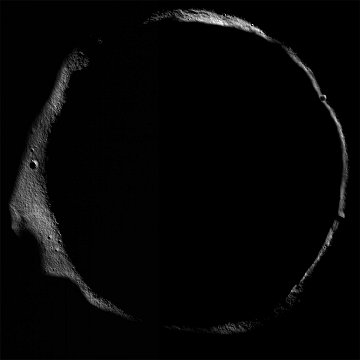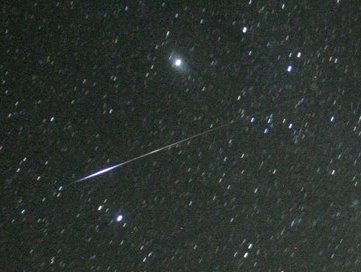| LAUNCH DELAYED: Space shuttle Discovery's spectacular night launch has been delayed. Bad weather around the Kennedy Space Center spoiled the first attempt on Tuesday morning, August 25th. Misson controllers plan to try again on Wednesday, August 26th at 1:10 a.m. EDT. Stay tuned for updates. ETERNAL DARKNESS: For years, planetary scientists have speculated about places on the Moon where the sun never shines. NASA may have just found one of them. Behold the inky depths of Crater Erlanger: 
NASA's Lunar Reconnaissance Orbiter (LRO) flew over the 10-km crater last week and took a look inside. It was pure shadow. Crater Erlanger is near the Moon's north pole. Because the Moon's spin axis is tilted only 1.5 degrees, sunlight cannot surmount the crater's steep rim to flood the interior. What lies inside the darkness? An exciting possibility is frozen water. Temperatures in the dark bottom could be as low as -370 Fahrenheit, cold enough to keep ice from sublimating even in hard lunar vacuum. Ice in dark craters could be an invaluable resource for future human explorers. Just melt and drink. Or split H2O into hydrogen for rocket fuel and oxygen for breathing. Water also makes an excellent radiation shield. Two spacecraft, the LRO and India's Chandrayaan-1 probe, are pinging the crater using onboard radars to learn more about Erlanger's hidden deposits. Get the full story from Arizona State University. RANDOM BEAUTY: Just before sunrise on Sunday, Aug. 23rd, Brian Emfinger spotted a meteor streaking past the bright star Capella: 
Photo details: Canon Digital Rebel XT, ISO 1600, F3.5, 1min exp
"I thought it might be an early Aurigid," says Emfinger, "but the radiant didn't match. I looked at some of the other minor showers that occur around now and their radiants didn't match either. It must have been a random meteor!" That's exactly what it was. The inner solar system is littered with random bits of debris from comets and asteroids, ranging in size from microscopic dust to sofa-sized boulders. Earth sweeps up tons of the stuff every day. Standing out under the stars on a clear dark night, you can expect to see between five and ten random or 'sporadic' meteors every hour. It's a slow but lovely meteor shower that lasts all year long. Be alert for random beauty!
August 2009 Aurora Gallery
[previous Augusts: 2008, 2007, 2006, 2005, 2004, 2003, 2002, 2001]
2009 Perseid Photo Gallery
[Science@NASA: The Perseids are Coming, Horse Flies and Meteors]
Explore the Sunspot Cycle | 
